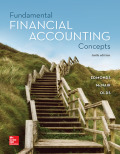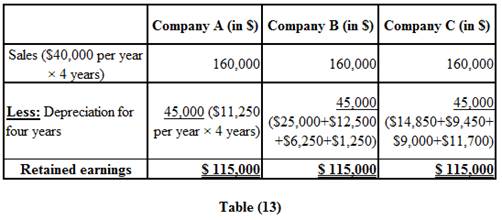
a.
Identify the company which will report the highest amount of net income for Year 1.
a.
Explanation of Solution
Net Income
Net income is the sum total of all the revenues generated in a particular accounting period after deducting cost of goods sold and expenses and losses, such as rent expense, depreciation of that particular accounting period.
Identify the company which will report the highest amount of net income for Year 1.
| Net Income for Year 1 | |||
| Company A (in $) | Company B (in $) | Company C (in $) | |
| Revenue | 40,000 | 40,000 | 40,000 |
| Less: Depreciation expense | 11,250 | 25,000 | 14,850 |
| Net Income | $28,750 | $15,000 | $25,150 |
Table (1)
Working Note:
Prepare depreciation schedule under straight-line method for Company A.
| Date | Depreciation Rate (B) | Depreciation expense (in $) | |
| Year 1 | 45,000 | 1/4 | 11,250 |
| Year 2 | 45,000 | 1/4 | 11,250 |
| Year 3 | 45,000 | 1/4 | 11,250 |
| Year 4 | 45,000 | 1/4 | 11,250 |
Table (2)
Calculate the depreciable cost.
Prepare depreciation schedule under double-declining-balance (DDB) method for Company B.
| Date | Double-Declining-Balance Depreciation Rate (A) | Book Value (Refer note) (in $) (B) | Depreciation expense (in $) |
| Year 1 | 0.50 | 50,000 | 25,000 |
| Year 2 | 0.50 | 25,000 | 12,500 |
| Year 3 | 0.50 | 12,500 | 6,250 |
| Year 4 | 0.50 | 6,250 | 1,250 |
Table (3)
Note:
Book value:
The amount of acquisition cost of less
Formula for book value:
Accumulated depreciation:
The total amount of depreciation expense deducted, from the time asset acquired till date, as reported in the account as on a particular date, is referred to as accumulated depreciation.
Formula for accumulated depreciation:
Determine the depreciation rate applied each year.
Useful life = 4 years
Compute depreciation expense on Year 4.
Prepare depreciation schedule under units-of-production method for Company C.
| Date | Depreciation per unit (A) | Number of miles (B) | Depreciation expense (in $) |
| Year 1 | $0.225 | 66,000 | 14,850 |
| Year 2 | $0.225 | 42,000 | 9,450 |
| Year 3 | $0.225 | 40,000 | 9,000 |
| Year 4 | $0.225 | 60,000 | 11,700 |
Table (4)
Compute depreciation per unit.
Compute depreciation expense on Year 4.
Hence, the company which will report the highest amount of net income for Year 1 is Company A.
b.
Identify the company which will report the lowest amount of net income for Year 4.
b.
Explanation of Solution
Net Income
Net income is the sum total of all the revenues generated in a particular accounting period after deducting cost of goods sold and expenses and losses, such as rent expense, depreciation of that particular accounting period.
Identify the company which will report the lowest amount of net income for Year 4.
| Net Income for Year 4 | |||
| Company A (in $) | Company B (in $) | Company C (in $) | |
| Revenue | 40,000 | 40,000 | 40,000 |
| Less: Depreciation expense | 11,250 | 1,250 | 11,700 |
| Net Income | $28,750 | $38,750 | $28,300 |
Table (5)
Working Note:
Prepare depreciation schedule under straight-line method for Company A.
| Date | Depreciable Cost (in $) (A) | Depreciation Rate (B) | Depreciation expense (in $) |
| Year 1 | 45,000 | 1/4 | 11,250 |
| Year 2 | 45,000 | 1/4 | 11,250 |
| Year 3 | 45,000 | 1/4 | 11,250 |
| Year 4 | 45,000 | 1/4 | 11,250 |
Table (6)
Calculate the depreciable cost.
Prepare depreciation schedule under double-declining-balance (DDB) method for Company B.
| Date | Double-Declining-Balance Depreciation Rate (A) | Book Value (Refer note) (in $) (B) | Depreciation expense (in $) |
| Year 1 | 0.50 | 50,000 | 25,000 |
| Year 2 | 0.50 | 25,000 | 12,500 |
| Year 3 | 0.50 | 12,500 | 6,250 |
| Year 4 | 0.50 | 6,250 | 1,250 |
Table (7)
Note:
Book value:
The amount of acquisition cost of less accumulated depreciation as on a particular date is referred to as book value.
Formula for book value:
Accumulated depreciation:
The total amount of depreciation expense deducted, from the time asset acquired till date, as reported in the account as on a particular date, is referred to as accumulated depreciation.
Formula for accumulated depreciation:
Determine the depreciation rate applied each year.
Useful life = 4 years
Compute depreciation expense on Year 4.
Prepare depreciation schedule under units-of-production method for Company C.
| Date | Depreciation per unit (A) | Number of miles (B) | Depreciation expense (in $) |
| Year 1 | $0.225 | 66,000 | 14,850 |
| Year 2 | $0.225 | 42,000 | 9,450 |
| Year 3 | $0.225 | 40,000 | 9,000 |
| Year 4 | $0.225 | 60,000 | 11,700 |
Table (8)
Compute depreciation per unit.
Compute depreciation expense on Year 4.
Hence, the company which will report the lowest amount of net income for Year 4 is Company C.
c.
Identify the company which will report the highest book value on the December 31, Year 3,
c.
Explanation of Solution
Book value:
The amount of acquisition cost of less accumulated depreciation as on a particular date is referred to as book value.
Formula for book value:
Identify the company which will report the highest book value on the December 31, Year 3, balance sheet.
| Book value on December 31, Year 3 | |||
| Company A (in $) | Company B (in $) | Company C (in $) | |
| Cost | 50,000 | 50,000 | 50,000 |
| Less: Accumulated depreciation | 33,750 | 43,750 | 33,300 |
| Book value | $16,250 | $6,250 | $16,700 |
Table (9)
Working Note:
Prepare depreciation schedule under straight-line method for Company A.
| Date | Depreciable Cost (in $) (A) | Depreciation Rate (B) | Depreciation expense (in $) | Accumulated Depreciation (in $) |
| Year 1 | 45,000 | 1/4 | 11,250 | 11,250 |
| Year 2 | 45,000 | 1/4 | 11,250 | 22,500 |
| Year 3 | 45,000 | 1/4 | 11,250 | 33,750 |
Table (10)
Calculate the depreciable cost.
Prepare depreciation schedule under double-declining-balance (DDB) method for Company B.
| Date | Double-Declining-Balance Depreciation Rate (A) | Book Value (Refer note) (in $) (B) | Depreciation expense (in $) | Accumulated Depreciation (in $) |
| Year 1 | 0.50 | 50,000 | 25,000 | 25,000 |
| Year 2 | 0.50 | 25,000 | 12,500 | 37,500 |
| Year 3 | 0.50 | 12,500 | 6,250 | 43,750 |
Table (11)
Note:
Book value:
The amount of acquisition cost of less accumulated depreciation as on a particular date is referred to as book value.
Formula for book value:
Accumulated depreciation:
The total amount of depreciation expense deducted, from the time asset acquired till date, as reported in the account as on a particular date, is referred to as accumulated depreciation.
Formula for accumulated depreciation:
Determine the depreciation rate applied each year.
Useful life = 4 years
Prepare depreciation schedule under units-of-production method for Company C.
| Date | Depreciation per unit (A) | Number of miles (B) | Depreciation expense (in $) | Accumulated Depreciation (in $) |
| Year 1 | $0.225 | 66,000 | 14,850 | 14,850 |
| Year 2 | $0.225 | 42,000 | 9,450 | 24,300 |
| Year 3 | $0.225 | 40,000 | 9,000 | 33,300 |
Table (12)
Compute depreciation per unit.
Hence, the company which will report the highest book value on the December 31, Year 3, balance sheet is Company C.
d.
Identify the company which will report the highest amount of
d.
Explanation of Solution
Retained earnings:
The retained earnings statement is that financial statement which shows the amount of net income which is actually retained by the Company on a particular date. These earnings can be utilized by the Company for the reinvestment and to pay its debts.

Hence, the retained earnings for all the companies are the same on the December 31, Year 4, balance sheet, as the total depreciation over the four year period is the same for all the three companies.
e.
Identify the company which will report the lowest amount of cash flow from operating activities on the Year 3 statement of
e.
Explanation of Solution
Statement of cash flows:
This statement reports all the cash transactions which are responsible for inflow and outflow of cash, and result of these transactions is reported as ending balance of cash at the end of reported period.
Cash flows from operating activities:
These refer to the cash received or cash paid in day-to-day operating activities of a company. In this direct method, cash flow from operating activities is computed by using all cash receipts and cash payments during the year.
Depreciation expense is not a
Want to see more full solutions like this?
Chapter 8 Solutions
Fundamental Financial Accounting Concepts
- Can you demonstrate the proper approach for solving this financial accounting question with valid techniques?arrow_forwardWhat is the net operating income for the month under variable costing?arrow_forwardC.S. Cullumber Company had the following transactions involving notes payable. July 1, 2025 Nov. 1, 2025 Dec. 31, 2025 Borrows $37,950 from First National Bank by signing a 9-month, 8% note. Borrows $41,000 from Lyon County State Bank by signing a 3-month, 6% note. Prepares adjusting entries. Feb. 1, 2026 Pays principal and interest to Lyon County State Bank. Apr. 1, 2026 Pays principal and interest to First National Bank. Prepare journal entries for each of the transactions. (List all debit entries before credit entries. Credit account titles are automatically indented when amount is entered. Do not indent manually. If no entry is required, select "No Entry" for the account titles and enter O for the amount in the relevant debit OR credit box. Entering zero in ALL boxes will result in the question being marked incorrect. Record journal entries in the order presented in the problem.)arrow_forward

 AccountingAccountingISBN:9781337272094Author:WARREN, Carl S., Reeve, James M., Duchac, Jonathan E.Publisher:Cengage Learning,
AccountingAccountingISBN:9781337272094Author:WARREN, Carl S., Reeve, James M., Duchac, Jonathan E.Publisher:Cengage Learning, Accounting Information SystemsAccountingISBN:9781337619202Author:Hall, James A.Publisher:Cengage Learning,
Accounting Information SystemsAccountingISBN:9781337619202Author:Hall, James A.Publisher:Cengage Learning, Horngren's Cost Accounting: A Managerial Emphasis...AccountingISBN:9780134475585Author:Srikant M. Datar, Madhav V. RajanPublisher:PEARSON
Horngren's Cost Accounting: A Managerial Emphasis...AccountingISBN:9780134475585Author:Srikant M. Datar, Madhav V. RajanPublisher:PEARSON Intermediate AccountingAccountingISBN:9781259722660Author:J. David Spiceland, Mark W. Nelson, Wayne M ThomasPublisher:McGraw-Hill Education
Intermediate AccountingAccountingISBN:9781259722660Author:J. David Spiceland, Mark W. Nelson, Wayne M ThomasPublisher:McGraw-Hill Education Financial and Managerial AccountingAccountingISBN:9781259726705Author:John J Wild, Ken W. Shaw, Barbara Chiappetta Fundamental Accounting PrinciplesPublisher:McGraw-Hill Education
Financial and Managerial AccountingAccountingISBN:9781259726705Author:John J Wild, Ken W. Shaw, Barbara Chiappetta Fundamental Accounting PrinciplesPublisher:McGraw-Hill Education





